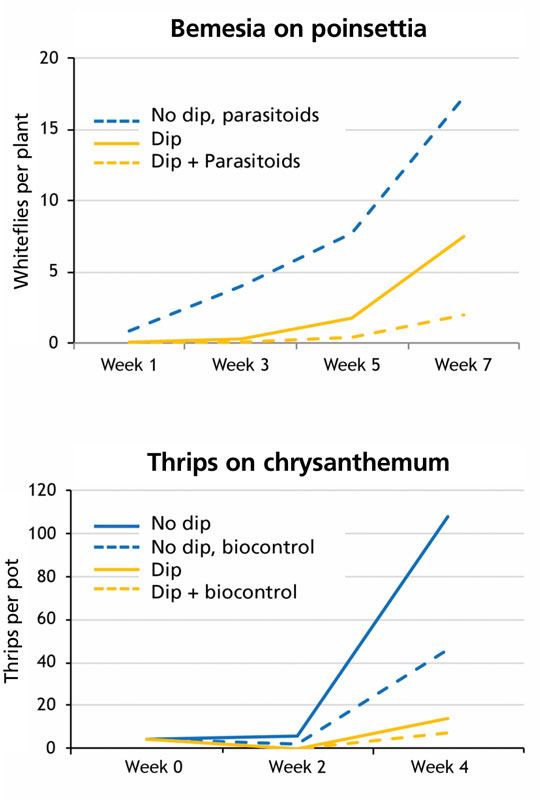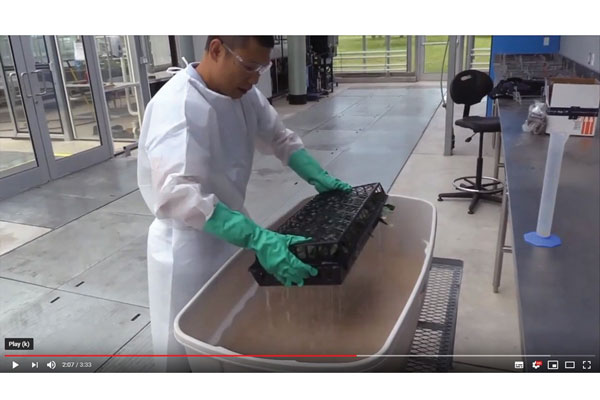2/1/2019
Start Clean by Dipping Unrooted Cuttings
Rose Buitenhuis & Ashley Summerfield

It’s one thing to use biocontrol to manage pests in a greenhouse, but it’s even better not to welcome them into the facility in the first place. Growers are catching on to that idea thanks to the research conducted at the Vineland Research and Innovation Centre (Vineland).
In a 2018 survey conducted by Vineland, two-thirds of Canadian growers who participated said they’re using cutting dips to eradicate pests before new ornamental crops take root in their greenhouses. More than 80% also said it’s a practice they’ll continue using to keep bugs at bay.
Vineland has been instrumental in developing methods to dip imported plant cuttings (which greenhouse flower growers typically use to start new flower crops) in insecticidal oils or soaps, or biopesticides to kill pests. They’re also working with product manufacturers and Flowers Canada (Ontario), Inc. to change labeling on existing pest control products to include cuttings dips as an approved use.
A lot of cuttings aren’t as clean as you’d like them to be. Cutting producers do spray for pests during production; however, low levels of pests like whiteflies and thrips can survive and are difficult to detect when they arrive in a facility.
Figure 1. Greenhouse trials on Bemisia whiteflies and western flower thrips to determine the value of adding unrooted cutting dips to a regular IPM program.
For example, 2018 has been a difficult year for poinsettia growers. Higher numbers of Bemisia whiteflies were found on certain batches of unrooted cuttings and these whiteflies were also more likely to be resistant to pesticides.
In the case of thrips, Vineland sampled chrysanthemum cuttings between July 2017 and March 2018, and found that 84% of them contained one or two thrips per batch of 20 cuttings. Given the fact that thrips can lay up to 300 eggs in their lifetime, those small numbers can quickly get out of control.
Dipping unrooted cuttings into an oil, soap or biopesticide significantly reduces the risk of pests hitching a ride onto planting stock. Our research showed that this technique will take care of 70% to 80% of whiteflies and thrips that come in and basically sets the clock back on pest population development for weeks so growers can implement an effective biocontrol program.
Previously, we determined the best products and rates for maximum efficacy and minimal risk of phytotoxicity (read about poinsettia dips in the April 2017 issue of GrowerTalks). To demonstrate the value of dips in an IPM program, several greenhouse trials were conducted. For both whiteflies on poinsettias and thrips on chrysanthemums, a clear difference was observed when cuttings were dipped before releasing biocontrol agents, compared to a regular biocontrol program (Figure 1).
An accidental two-spotted spider mite infestation on chrysanthemums in the thrips greenhouse experiment allowed us to observe that cutting dips in oil-based products also seem to control this common pest.
A few technical tips
• Dip rates are lower than spray rates to prevent phytotoxicity. We only tested a few of the most common potted plant species and varieties. Do your own tests on a small batch before committing to a full dip program.
• We obtained best results for Bemisia whiteflies on poinsettias using two recipes: either 0.5% (v/v) Kopa insecticidal soap mixed with 1.25 g/L BotaniGard 22WP or 0.1% (v/v) SuffOil-X.
• 0.1% to 0.5% (v/v) mineral oil (e.g., Landscape oil or SuffOil-X) or 2.5 g/L BotaniGard 22WP will control thrips on various crops. Adjust the rate according to the sensitivity of the crop to oil-based products.
• Products used in dips work on contact with pests, so total coverage of the foliage is required. Do not pack the cuttings too tightly and check for dry spots after the cuttings are dipped.
• Good sanitation is essential. Although we’ve shown previously that the risk of disease (e.g., Erwinia/Pectobacterium) transfer through the dip is minimal, you’re dipping a lot of cuttings in the same tank. That said, do not dip obviously stressed cuttings, as this may add additional strain and make cuttings more susceptible to pathogens or reduce their vigor in propagation.
 (Not sure how to dip? Check out a short video that explains the process step by step at https://tinyurl.com/cuttingdips [Figure 2]).
(Not sure how to dip? Check out a short video that explains the process step by step at https://tinyurl.com/cuttingdips [Figure 2]).
Industry feedback on this research has been very positive. The project was originally meant to give growers a better chance at succeeding with biological pest control, but dips also fit well within a pesticide-based program. In one instance, a grower said dipping cuttings reduced his pesticide applications by 50%.
In short, dip treatments of unrooted cuttings are effective against several pests on different crops, allowing growers to start clean—an important beginning for a successful IPM program. GT
The whitefly project was funded in part by Dümmen Orange, BioWorks, Koppert Canada and Flowers Canada (Ontario) Inc. The thrips research was funded by the American Floral Endowment in collaboration with BioWorks, Neudorff and collaborating greenhouses in Niagara, Ontario.
Rose Buitenhuis is a researcher and Ashley Summerfield is a research technician of biological control at the Vineland Research & Innovation Centre in Ontario, Canada.